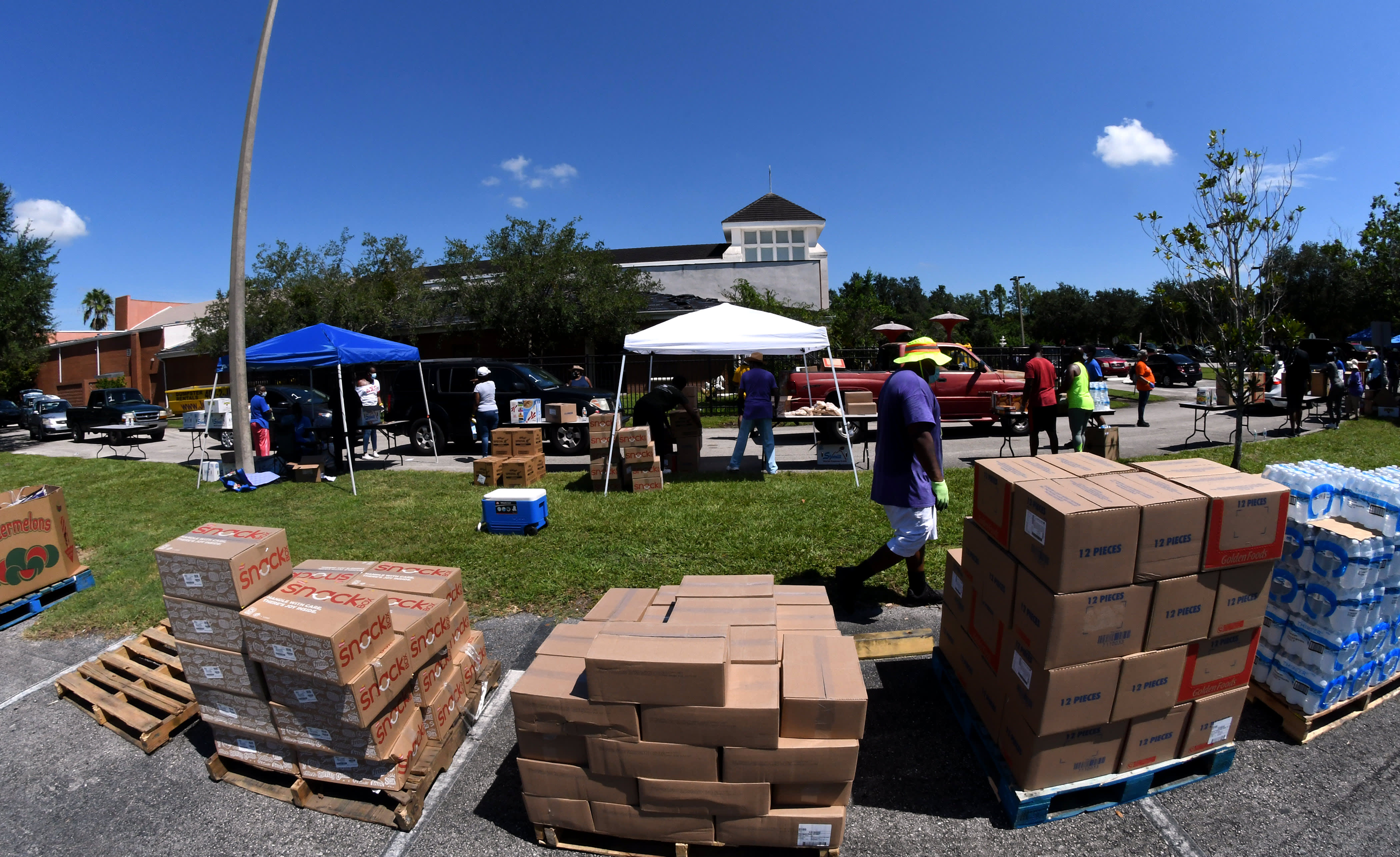Food banks in the Orlando, Florida, area face continued demand as unemployment due to the Covid-19 pandemic persists.
Paul Hennessy/NurPhoto via Getty Images
States are starting to run out of funding for enhanced unemployment benefits, leaving millions of workers without additional aid as hopes for more stimulus dwindle.
At least nine states — including Alabama, Arizona, Idaho, Massachusetts, Missouri, New Hampshire, Rhode Island, Texas and Utah — have finished paying a $300 weekly unemployment subsidy to workers eligible for the money to date, according to state officials.
Others, like North Carolina and Tennessee, are poised to finish disbursing the aid, made through a federal Lost Wages Assistance program, as soon as this week.
States received federal grants for up to six weeks of payments, for a total of $1,800, which is available to individuals receiving unemployment benefits between the weeks ended Aug. 1 and Sept. 5.
Now, workers again face the prospect of no additional federal aid, at a time when nearly 30 million people are still collecting jobless benefits six months into the coronavirus-fueled economic crisis.
“This is a stopgap measure we always knew wasn’t going to be able to last very long,” Ioana Marinescu, an assistant professor of economics at the University of Pennsylvania, said of the Lost Wages program. “It’s better than nothing, for sure.
“But this wasn’t meant to last.”
Stimulus grows more unlikely
Congress and White House officials have been locked in a stalemate over more stimulus measures for weeks. Earlier relief programs to combat the economic repercussions of the coronavirus pandemic, including one that offered an extra $600 a week in unemployment benefits, expired near the end of July.
The congressional fight to replace Supreme Court justice Ruth Bader Ginsburg, who passed away on Friday due to complications with cancer and was among the liberal members of the high court, risked overwhelming congressional stimulus talks before Election Day.
House Speaker Nancy Pelosi speaks during a press conference on Capitol Hill on Sept. 10, 2020.
Ting Shen/Xinhua via Getty Images
House Democrats proposed a relief package totaling roughly $3 trillion in May that sought to extend the $600 weekly unemployment supplement through early next year. Senate Republicans unveiled a $1 trillion countermeasure in July, days before that supplement was to expire, that instead offered a $200 weekly boost.
In the absence of a deal, unemployed workers are left with their state-allotted aid, which averaged $305 a week last month, according to the Labor Department. Benefits dipped as low as $180 a week, on average, in states like Louisiana and Mississippi.
More from Personal Finance:
Still no stimulus check? These IRS deadlines could apply
What a Biden presidential win may mean for Social Security
The pandemic is driving millions of ‘working poor’ to the edge
A failure to pass additional relief measures for unemployed Americans would deepen the inequality exposed by the current economic downturn, Marinescu said.
“This is going to be hardest on more disadvantaged, lower-income individuals and communities of color because they’ve been disproportionately impacted by job loss,” Marinescu said. “Also, a dollar means more to a poor person than a rich person.
“Losing those precious dollars is really a meaningful loss for those people.”
At the same time, it would impair the U.S. economic recovery, Marinescu said.
Eliminating the $600 weekly supplement, enacted by the CARES Act relief law in March, would reduce consumer spending by 44% at the local level, economists estimated in a paper published last month by the National Bureau of Economic Research.
$300 unemployment boost
The $300 Lost Wages Assistance subsidy, created by the Trump administration in early August, comes on top of state-level benefits. The program diverts up to $44 billion of federal disaster-relief funding toward the measure.
More than $39 billion had been distributed to approved states and territories as of Monday morning, according to the Federal Emergency Management Agency, which is overseeing the program.
Forty-nine states applied for the aid (South Dakota was the only one that didn’t.) States received an initial three weeks of funding and had to reapply for the three additional weeks.
Thirty-nine states have received the full six weeks of grants, according to FEMA, and are in various stages of issuing the aid to eligible workers.
States that have already disbursed aid to all eligible workers to date are continuing to pay out money to newly eligible workers.
In Texas, for example, there are “a lot of cases” where a worker’s unemployment application may have been delayed — perhaps if the state was waiting for additional information from an employer — and is approved after Sep. 5. Such workers would then get the $300 subsidy as long as they were unemployed in August.
“Texas will pay those claims until there are no more claims or until FEMA requests us to stop paying,” according to a spokesman for the Texas Workforce Commission.
Idaho is another state that’s paid all eligible claimants to date. However, workers in that state will only get five, not six, total payments, according to a spokesman for the state Labor Department.
